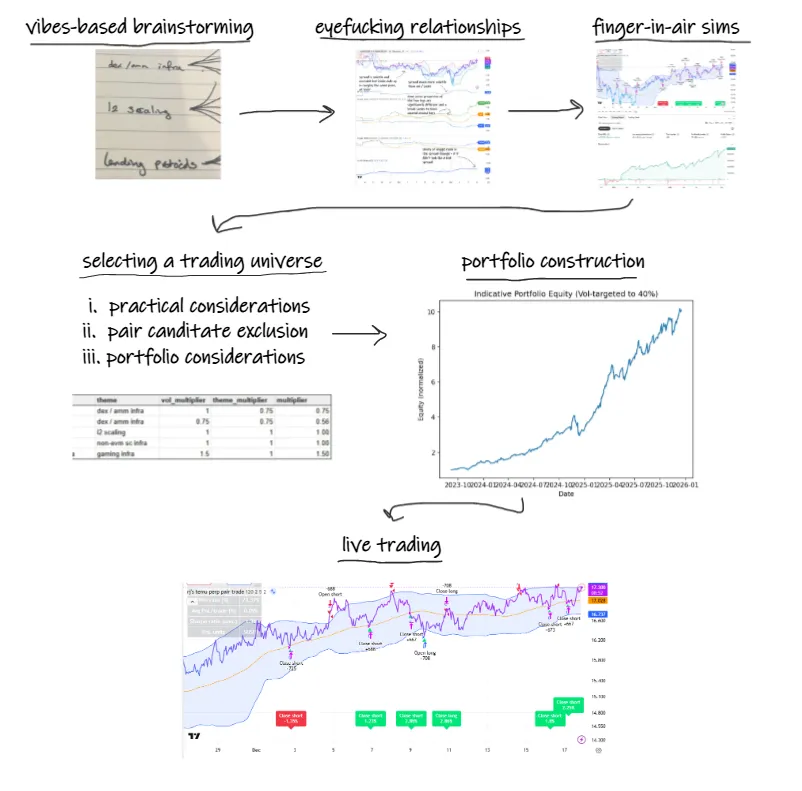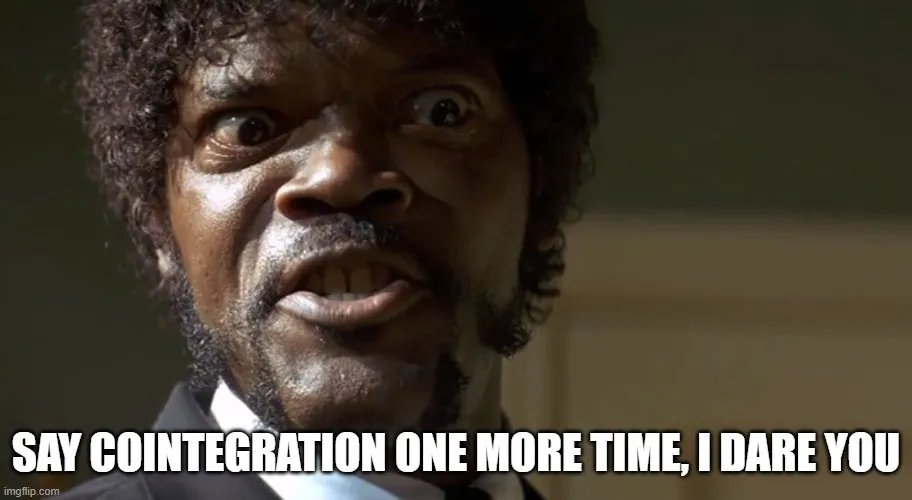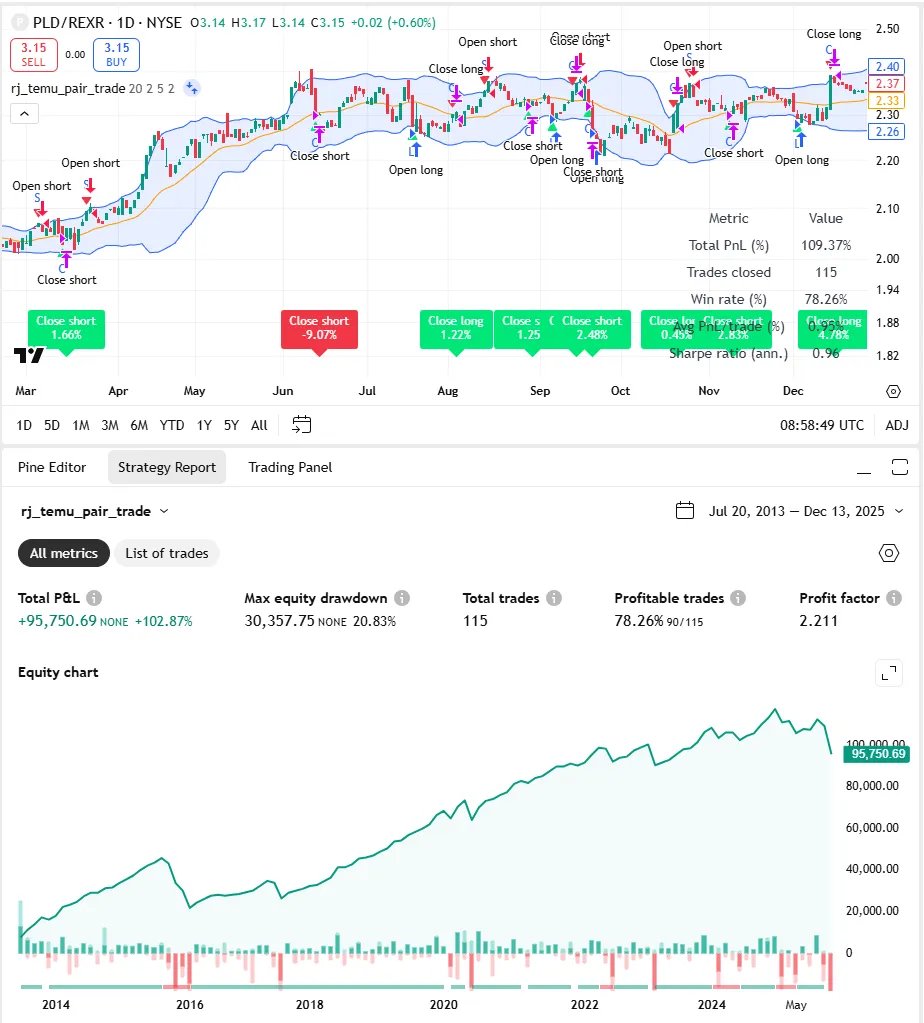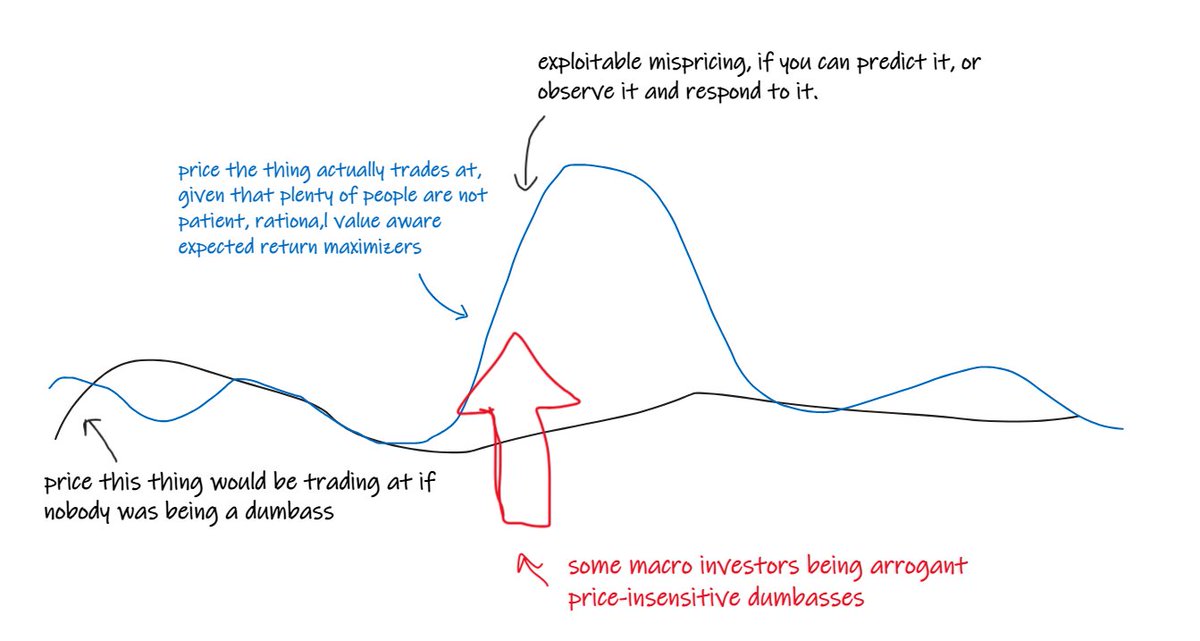Option Pricing for Degenerate Gamblers
You buy a call option in a heavily pumped meme stock you think is going to keep going up.
You were right, it keeps going up!
But your call is losing value. Why?
🧵for those who shouldn't be trading options but are going to anyway!
1/n
You buy a call option in a heavily pumped meme stock you think is going to keep going up.
You were right, it keeps going up!
But your call is losing value. Why?
🧵for those who shouldn't be trading options but are going to anyway!
1/n
Without a good mental model, then the price of an option contract may appear to change in confusing and magical ways.
With a good model, you will understand the most important dynamics intuitively - without needing any complex maths.
This is the 101 before the 101.
2/n
With a good model, you will understand the most important dynamics intuitively - without needing any complex maths.
This is the 101 before the 101.
2/n
[A quick administrative note so I don't confuse anyone:
To keep it simple we're going to inhabit a world where:
- options are European style
- interest rates, risk-premia, dividends, and other carrying costs don't exist.
i.e. we're gonna inhabit a risk-neutral world]
3/n
To keep it simple we're going to inhabit a world where:
- options are European style
- interest rates, risk-premia, dividends, and other carrying costs don't exist.
i.e. we're gonna inhabit a risk-neutral world]
3/n
Consider a stock that is trading at $100 and whose price has been wiggling around like stocks tend to.
You buy a call option, struck at $100, expiring in 10 days' time.
4/n
You buy a call option, struck at $100, expiring in 10 days' time.
4/n

This gives you the *option* (geddit?) to buy the stock at $100 on the expiry date - regardless of what price the asset is trading on the market.
Whether this is valuable or not depends on the price of the stock on the expiry date.
5/n
Whether this is valuable or not depends on the price of the stock on the expiry date.
5/n
If we get to the expiry date and the stock is trading lower than $100 (our strike price) then our option is worthless.
Being able to buy the stock at $100 isn't worth anything when we can buy it cheaper on the stock market.
6/n
Being able to buy the stock at $100 isn't worth anything when we can buy it cheaper on the stock market.
6/n

If we get to the expiry date and the stock is trading higher than $100 (our strike price) then our option has some value.
Being able to buy the stock at $100 is valuable if we could sell it for more money on the stock market.
7/n
Being able to buy the stock at $100 is valuable if we could sell it for more money on the stock market.
7/n

If the stock were trading at $110 at the expiry, we could:
- exercise the option to buy the stock at $100
- sell it in the market at $110
- make $10 profit per share.
8/n
- exercise the option to buy the stock at $100
- sell it in the market at $110
- make $10 profit per share.
8/n

You can probably tell we have some asymmetry here.
If the stock trades below $100 at expiry, the option is always worth $0.
But it gets increasingly valuable the higher above $100 the stock price is at expiry.
9/n
If the stock trades below $100 at expiry, the option is always worth $0.
But it gets increasingly valuable the higher above $100 the stock price is at expiry.
9/n
If we plotted the value of the option in green as a function of the stock price at expiry it would look kinky.
This kinkiness is what makes options interesting.
If the stock goes up a lot, the option will be worth a lot. But it can never be worth less than $0.
10/n
This kinkiness is what makes options interesting.
If the stock goes up a lot, the option will be worth a lot. But it can never be worth less than $0.
10/n

We have an answer for "what this the value of the call option at expiry?"
If the price of the stock at expiry is less than the strike price, it's $0
If it's more than the strike price, then the value of the option is equal to how much higher the price is than the strike.
11/n
If the price of the stock at expiry is less than the strike price, it's $0
If it's more than the strike price, then the value of the option is equal to how much higher the price is than the strike.
11/n

That's the easy bit.
The more difficult and important question is "What should the option be worth before its expiry?"
And it should be clear that has something to do with the question:
"What is the price of the stock likely to be at expiry?"
12/n
The more difficult and important question is "What should the option be worth before its expiry?"
And it should be clear that has something to do with the question:
"What is the price of the stock likely to be at expiry?"
12/n

"I don't care if you're Warren Buffet or if you're Jimmy Buffet. Nobody knows if a stock is going to go up, down, sideways or in f-ing circles.
"Least of all, options traders."
If traders knew the stock was going to be $105 in 10 days time, it would already be that price
13/n
"Least of all, options traders."
If traders knew the stock was going to be $105 in 10 days time, it would already be that price
13/n

So options prices don't represent any intelligence about the direction the stock is likely to go in.
"Do you know what a Fugazi is?"
But they do represent a view on the *probability distribution* of stock prices at expiry.
I lost some of you there... Let's back up a bit.
14/n
"Do you know what a Fugazi is?"
But they do represent a view on the *probability distribution* of stock prices at expiry.
I lost some of you there... Let's back up a bit.
14/n
Look at my crappy picture again.
Based on what you know about stock prices and how they move, if stock is trading at $100, what is more likely?
Stock trades at $100 at expiry?
Stock trades at $150 at expiry?
Stock trades at $50 at expiry?
The first one, right?
15/n
Based on what you know about stock prices and how they move, if stock is trading at $100, what is more likely?
Stock trades at $100 at expiry?
Stock trades at $150 at expiry?
Stock trades at $50 at expiry?
The first one, right?
15/n

We can predict how likely the stock is to be trading at different prices at expiry.
We can do this by the "power of eyeball" or with a model.
However we do, the probability of getting to different prices at expiry is going to look something like the purple histogram.
16/n
We can do this by the "power of eyeball" or with a model.
However we do, the probability of getting to different prices at expiry is going to look something like the purple histogram.
16/n

Now, remember this thread about pricing bets?
The call option is really just a bet on the price of the stock at expiry.
(At least under our assumptions.)
17/n
https://twitter.com/therobotjames/status/1443695462054195225
The call option is really just a bet on the price of the stock at expiry.
(At least under our assumptions.)
17/n
To calculate the fair value of a bet we:
1. All the potential outcomes.
2. The probability of each occurring
3. The payoff if it occurs.
Then the fair value is the sum of:
[probability of outcome] * [payoff if it happens]
for all outcomes.
18/n
1. All the potential outcomes.
2. The probability of each occurring
3. The payoff if it occurs.
Then the fair value is the sum of:
[probability of outcome] * [payoff if it happens]
for all outcomes.
18/n

For the call option, the actual number of outcomes are continuous (or, more accurately, discrete in the tick size of the stock).
But we can work with discrete buckets. We don't need to be precise here to get some intuition.
It would look like something like this...
19/n
But we can work with discrete buckets. We don't need to be precise here to get some intuition.
It would look like something like this...
19/n

But we don't need to go through this to get an intuition about how the value of the call option changes.
We can simply understand (see kinkiness of green line)
- we are rewarded if the stock goes up a lot
- we are not penalized if it goes down a lot.
20/n
We can simply understand (see kinkiness of green line)
- we are rewarded if the stock goes up a lot
- we are not penalized if it goes down a lot.
20/n

So the primary driver of the value of the call option is simply:
"How likely is the stock to be up *a lot* by expiry?"
The bigger the orange shaded part of the histogram is, the more the option will be worth.
The smaller it is, the less it will be worth.
21/n
"How likely is the stock to be up *a lot* by expiry?"
The bigger the orange shaded part of the histogram is, the more the option will be worth.
The smaller it is, the less it will be worth.
21/n

Now - armed with this knowledge - you know everything you need to understand the most important dynamics impacting the call option price.
22/n
22/n
For example, imagine the price of the stock jumps up.
Now the chance of the stock price being high at expiry is much larger. The option is worth more.
This is the effect called "delta"
23/n
Now the chance of the stock price being high at expiry is much larger. The option is worth more.
This is the effect called "delta"
23/n

Now imagine time passes and the stock price ends up the same...
There's less chance left for the stock to get to those really high prices.
So the purple histogram is tighter.
The yellow area is smaller. So the option is worth less.
This is the effect called "theta"
24/n
There's less chance left for the stock to get to those really high prices.
So the purple histogram is tighter.
The yellow area is smaller. So the option is worth less.
This is the effect called "theta"
24/n

Now imagine the market thinks the stock is going to get a lot more volatile.
The chance of a really big stock price by expiry has now gone up.
The purple histogram is now fatter.
The yellow area is bigger. So the option is worth more.
This is the effect called "vega"
25/n
The chance of a really big stock price by expiry has now gone up.
The purple histogram is now fatter.
The yellow area is bigger. So the option is worth more.
This is the effect called "vega"
25/n

This is likely what happened with the meme stock example we started with.
If the market's view of how volatile the stock will be decreases significantly, then the call option is likely to lose value even if the stock goes up.
26/n
If the market's view of how volatile the stock will be decreases significantly, then the call option is likely to lose value even if the stock goes up.
26/n
Because the chance of the price getting to really high numbers by expiry has decreased even though the price went up.
If you understand and can picture this in your mind, you can work out nearly all the important sensitivities of an option contract.
Go forth and draw!
27/27
If you understand and can picture this in your mind, you can work out nearly all the important sensitivities of an option contract.
Go forth and draw!
27/27
I don't have space to do this in this thread...
But the way to get an edge in options trading is to be able to estimate the purple probability histogram (or some aspect of it) more accurately, on average, than the aggregate market.
Another time perhaps...❤️
But the way to get an edge in options trading is to be able to estimate the purple probability histogram (or some aspect of it) more accurately, on average, than the aggregate market.
Another time perhaps...❤️

• • •
Missing some Tweet in this thread? You can try to
force a refresh












